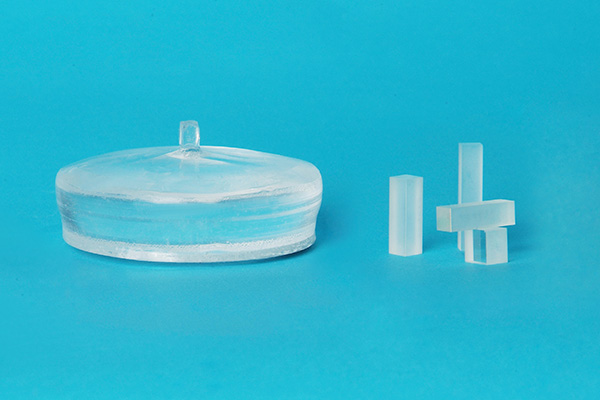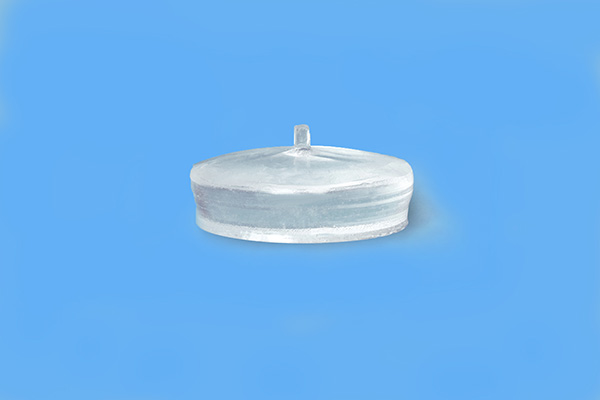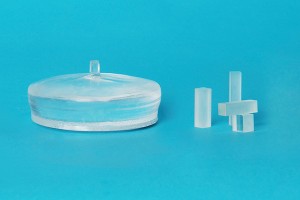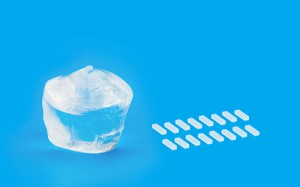BBO Crystal
α-BBO is a negative uniaxial crystal with large birefringence and broad transparent range from UV (190 nm) to mid-infrared (3500 nm). α-BBO grown by WISOPTIC has very good internal quality, less absorption, high extinction ratio and high UV transmission. α-BBO is widely used in deep UV and high power laser systems as devices of Gran prisms, polarizing beam splitters, compensator and so on.
ẞ-BBO is an excellent nonlinear crystal with combination of a number of unique features: wide transparency region, broad phase-matching range, large nonlinear coefficient, high damage threshold, and excellent optical homogeneity. Therefore, ẞ-BBO provides an attractive solution for various nonlinear optical applications such as OPA, OPCPA, OPO etc.
ẞ-BBO also has advantages of large thermal acceptance bandwidth, high damage threshold and small absorption, thus is very suitable for frequency conversion of high peak or average power laser radiation, e.g. harmonic generation of Nd:YAG, Ti:Sapphire and Alexandrite laser radiation. ẞ-BBO is the best NLO crystal for the fifth harmonic generation of Nd:YAG laser at 213 nm. Good laser beam quality (small divergence, good mode condition, etc.) is the key for ẞ-BBO to obtain high conversion efficiency.
Contact us for the best solution for your application of BBO crystals.
WISOPTIC Capabilities - BBO
• Aperture: 1x1 ~ 15x15 mm (ẞ-BBO)
• Length: 0.02 ~ 25 mm (ẞ-BBO);1.0 ~ 40 mm (α-BBO)
• End configuration: flat, or Brewster, or specified
• Top processing (polishing, coating) quality
• Mounting: upon request
• Very competitive price
WISOPTIC Standard Specifications* - BBO
| Dimension Tolerance | ± 0.1 mm |
| Angle Tolerance | < ± 0.25° |
| Flatness | < λ/10 @ 632.8 nm |
| Surface Quality | < 10/5 [S/D] |
| Parallelism | < 10” |
| Perpendicularity | ≤ 5' |
| Chamfer | ≤ 0.1 mm @ 45° |
| Transmitted Wavefront Distortion | < λ/8 @ 632.8 nm |
| Clear Aperture | > 90% central area |
| Coating | AR @ 1064nm(R<0.2%); PR |
| Laser Damage Threshold | > 1 GW/cm2 for 1064nm, 10ns, 10Hz (polished only) > 0.5 GW/cm2 for 1064nm, 10ns, 10Hz (AR-coated) > 0.3 GW/cm2 for 532nm, 10ns, 10Hz (AR-coated) |
| * Products with special requirement upon request. | |


Main Features - BBO
• Broad transparency range (189-3500 nm)
• Broad phase matching range (410-3500 nm)
• High optical homogeneity(δn≈10-6/cm)
• Relatively large effective SHG coefficient (about 6 times that of KDP)
• High damage threshold (compared with KTP and KDP)
Comparison of bulk damage threshold [1064nm, 1.3ns]
|
Crystals |
Energy fluence (J/cm²) |
Power density (GW/cm²) |
|
KTP |
6.0 |
4.6 |
|
KDP |
10.9 |
8.4 |
|
BBO |
12.9 |
9.9 |
|
LBO |
24.6 |
18.9 |
Primary Applications - BBO
• 2~5 HG (Harmonic generation) of Nd-doped YAG and YLF laser.
• 2~4 HG of Ti:Sapphire and Alexandrite laser.
• Frequency doublers, triplers, and wave mixers of Dye laser.
• Frequency doublers of Argon ion, Ruby, and Copper vapour laser.
• Widely tunable OPO, OPA, OPCPA of both Type I and Type II phase matching.
Physical Properties - BBO
| Chemical formula | ẞ-BaB2O4 |
| Crystal structure | Trigonal |
| Point group | 3m |
| Space group | R3c |
| Lattice constants | a=b=12.532 Å, c=12.717 Å |
| Density | 3.84 g/cm3 |
| Melting point | 1096 °C |
| Mohs hardness | 4 |
| Thermal conductivity | 1.2 W/(m·K) (┴c); 1.6 W/(m·K) (//c) |
| Thermal expansion coefficients | 4x10-6/K (┴c); 36x10-6/K (//c) |
| Hygroscopicity | some hygroscopic |
Optical Properties - BBO
| Transparency region (at “0” transmittance level) |
189-3500 nm | |||
| Refractive indices | 1064 nm | 532 nm | 266 nm | |
| ne=1.5425 no=1.6551 |
ne=1.5555 no=1.6749 |
ne=1.6146 no=1.7571 |
||
|
Linear absorption coefficients |
532 nm |
1064 nm |
||
| α = 0.01 /cm | α < 0.001 /cm | |||
|
NLO coefficients |
532 nm | 1064 nm | ||
| d22 = 2.6 pm/V | d22 = 2.2 pm/V | |||
|
Electro-optic coefficients |
low frequency | high frequency | ||
| 2.2 pm/V | 2.1 pm/V | |||
| Thermal-optic coefficients | dno/dT=-16.6x10-6/℃, dne/dT=-9.3x10-6/℃ | |||
| Half-wave voltage | 7 kV (at 1064 nm, 3x3x20 mm3) | |||






